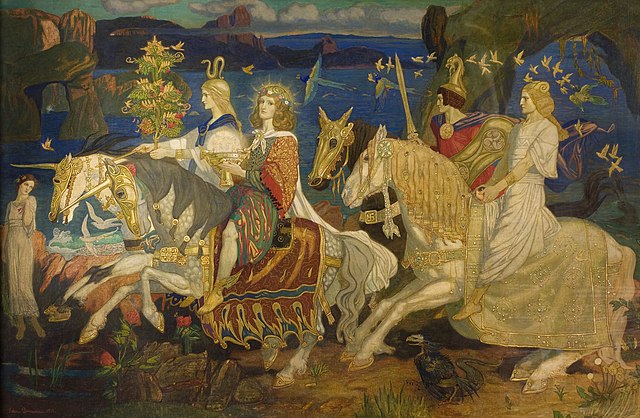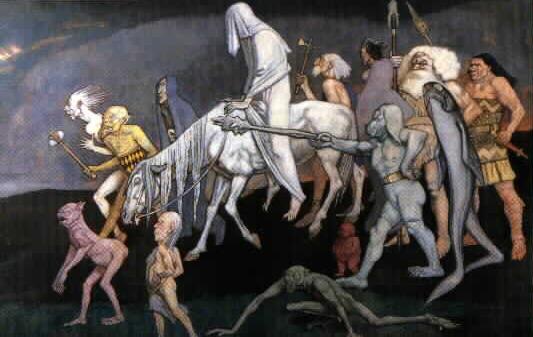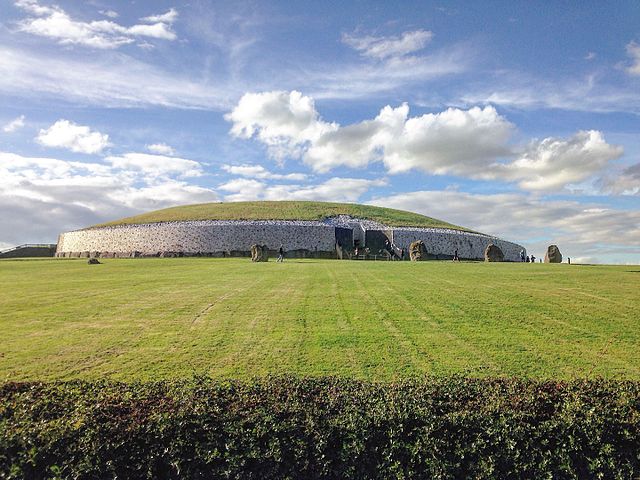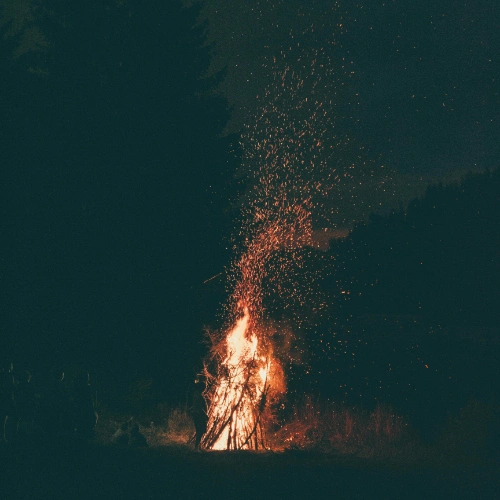Irish Myths: Tuatha Dé Danann in Ireland
The Tuatha Dé Danann, a group shrouded in mystery, are one of Irish mythology’s most intriguing enigmas. Known as the “People of the Goddess Danu,” they were a formidable race said to possess extraordinary magic and divine abilities. These legendary beings, central to Ireland’s folklore, are often depicted as gods and skilled warriors who shaped the land’s ancient history.
But who exactly were the Tuatha Dé Danann? Were they gods, supernatural heroes, or something else entirely? And what role did they play in shaping Ireland’s rich mythological landscape? Let’s dive into their story and uncover the secrets of this mythical race.
Don’t forget to read my article on Ireland’s Myths and Legends.
Table of Contents
Who Were the Tuatha Dé Danann?

The Tuatha Dé Danann, meaning “People of the Goddess Danu,” were a powerful race of beings from Irish mythology. They are often seen as god-like figures, deeply connected to magic, nature, and the supernatural.
According to legend, they were descended from the goddess Danu, who was believed to be a mother figure and a source of their strength and wisdom.
The Tuatha Dé Danann have been interpreted in various ways throughout history. Some see them as ancient gods who ruled over nature and the elements.
Others believe they might have been fallen angels with immense power but not quite divine. There’s also the idea that they could have been ancient heroes—warriors and leaders who became larger-than-life legends over time.
Regardless of interpretation, the Tuatha Dé Danann were known for their extraordinary abilities, including mastery over magic, advanced knowledge, and unrivalled battle skills. They stand out as a mythical race that was not only powerful but also deeply, almost mysteriously, connected to the spiritual world.
Where did the Tuatha Dé Danann Come From?
Legend has it that a group of people led by a man named Nemed arrived on the shores of Ireland. While trying to make a life on the Island, the Nemedians eventually came to the attention of a wicked race called the Famorians.
The Famorians force their will on the people of Nemed, who must give up most of their yearly crops, milk, and even children every Samhain (Halloween). Eventually, the Nemedians rise up and battle their oppressors, the Famorians, in a great battle. Unfortunately, they lose the battle, and most of their forces are killed.
The surviving Nemedians fled the Island of Ireland by sea. The survivors split up into three groups. One group sold up North of Ireland and became the Tuatha Dé Danann.
The second group flees to the Island of England and becomes the ancestors of the Britons. The third group flees to the south, to Greece, where they are captured and enslaved for many years. This group eventually returns to Ireland as the Fir Bolg.
It is believed that the Tuatha settled in the North, establishing four cities or Islands of great learning. These four locations were called Falias, Gorias, Finias, and Murias.
The Tuatha became great scholars of the arts, gaining knowledge in poetry, magic, music, healing, and combat. Their Druids became some of the most skilled and knowledgeable during this time.
During their time away from the Island of Ireland, the Tuatha prospered and grew in knowledge and strength. It is even said that they became so powerful in the magic arts that they became immortal.
Tuatha Da Danann Arrival in Ireland
The arrival of the Tuatha Dé Danann in Ireland is one of the most magical stories in Irish mythology. According to legend, they were summoned to return to the Island after a long absence.
When they arrived, it was unlike any ordinary landing. Some tales say they descended from the sky in great, flying ships. Others describe them emerging from a mystical mist that suddenly covered the land as if they had appeared from another world.
Once in Ireland, the Tuatha Dé Danann faced the Fir Bolg, the people who ruled the land at the time. The two groups soon went to war, and after a fierce battle known as the First Battle of Mag Tuired, the Tuatha emerged victorious.
However, instead of driving the Fir Bolg away completely, they reached an agreement. The Fir Bolg were allowed to keep a portion of Ireland, while the Tuatha claimed the rest.
This peaceful compromise set the stage for the Tuatha Dé Danann to rule as powerful, magical beings over much of Ireland, where their influence would shape the country’s mythology and history for generations to come.
Please read my article on the Legend of the Fir Bolg in Ireland for more information.
Key Figures of the Tuatha Dé Danann
When the Tuatha Dé Danann arrived in Ireland, they were led by a remarkable group of gods and goddesses, each with their own unique powers and responsibilities. Here are some of the main figures who played critical roles in their story:
- King Nuada: The leader of the Tuatha Dé Danann when they arrived in Ireland. Known for his bravery and wisdom, Nuada lost his arm in battle but was given a magical silver arm by the healer Diancecht, earning him the name Nuada of the Silver Hand.
- Manannán, Son of Lir: A sea god and the ruler of the Otherworld, Manannán had control over the oceans and could travel between worlds. He was also known for his magical cloak that could change colour and his boat that required no sails.
- Ogma: A god of strength, learning, and eloquence, Ogma is credited with creating the ancient Ogham script, an early form of Irish writing. He was a mighty warrior and a wise scholar.
- Dian Cécht: The skilled physician of the Tuatha Dé Danann, Dian Cécht could heal even the most severe injuries. He created King Nuada’s silver arm and had a magical well that could heal the wounded.
- Neit: The god of war, Neit represented the chaos and destruction of battle. His fierce nature made him a formidable presence in conflicts.
- Credne: A master craftsman, Credne worked with metals to create weapons, armour, and tools for the Tuatha Dé Danann. His skills were crucial in preparing the Tuatha for battle.
- Goibniu: Another skilled craftsman, Goibniu, was a divine blacksmith who forged magical weapons, including spears that never missed their mark. His craftsmanship played a vital role in the Tuatha’s success in battle.
- Badb, Macha, and Morrígan: These three goddesses, often referred to as the triple goddesses of war, had the power to influence battles. The Morrígan, in particular, was known as the goddess of fate and could shape the outcome of wars by predicting the deaths of warriors.
- Brigid: A goddess of poetry, healing, and fire, Brigid was beloved for her nurturing and creative energy. She embodied wisdom, inspiration, and the spark of life.
- Dagda: The Dagda was one of the most important gods of the Tuatha Dé Danann, known as the “Good God.” He had immense strength and magical powers, wielding a giant club that could both kill and heal. He was also the keeper of a magical cauldron that never ran empty, symbolizing abundance and nourishment.
Each of these figures brought their own unique talents and strengths, making the Tuatha Dé Danann a powerful and legendary force in Irish mythology.
Please read my article on Irish Gods and Goddesses for more information.
The Tuatha Dé Danann and Their Conflict with the Fomorians

After settling in Ireland, the Tuatha Dé Danann faced a new challenge: the Fomorians. The Fomorians were a race of powerful, monstrous beings who lived in Ireland before the Tuatha arrived. They were often depicted as giants or sea creatures, feared for their destructive power and chaotic nature.
Tensions between the Tuatha Dé Danann and the Fomorians eventually led to a series of battles. The Second Battle of Mag Tuired was the most famous, decisive conflict.
At the time, the Tuatha Dé Danann were ruled by their king, Bres, who was half Tuatha and half Fomorian. Though he became king after King Nuada was injured, Bres proved to be a harsh and unfair ruler, favouring the Fomorians over his own people.
The Tuatha decided they could no longer tolerate Bres’ rule and prepared for battle against the Fomorians. In this great conflict, some of the most important figures of the Tuatha played crucial roles.
Lugh of the Longarm, a skilled warrior and master of many talents, took command. He was famous for his quick thinking and unmatched strategy and combat abilities.
The Tuatha Dé Danann fought bravely against the Fomorians. Still, Lugh struck the final blow, defeating the Fomorian leader Balor, a giant with a deadly, poisonous eye.
According to legend, Lugh hurled a spear or stone that pierced Balor’s eye, ending his reign of terror and ensuring victory for the Tuatha Dé Danann.
This battle marked a turning point, freeing the Tuatha from the Fomorians’ control and solidifying their place as rulers of Ireland. Their victory in this epic struggle became one of the most critical moments in Irish mythology, showcasing their strength, unity, and bravery.
Please read my article on the Legends of the Fomorians in Ireland for more information.
The Decline of the Tuatha Dé Danann

After ruling Ireland for many years, the Tuatha Dé Danann faced their final challenge: the arrival of the Milesians, the mortal ancestors of the Irish people.
The Milesians, led by influential leaders, came to Ireland seeking to claim the land for themselves. A great conflict broke out between the Tuatha and the Milesians, but this time, the Tuatha were not victorious.
According to legend, the Milesians defeated the Tuatha Dé Danann using strategy and magic. After their defeat, the Tuatha knew their time ruling Ireland had come to an end.
Instead of disappearing, they retreated to the Otherworld, a hidden, magical realm that exists alongside the human world.
In this Otherworld, the Tuatha Dé Danann transformed into the Aos Sí, or Sidhe, the mystical beings often referred to as fairies in Irish folklore. Though no longer rulers of Ireland, they continued to exist in the shadows, living in places like ancient mounds and hills known as “fairy forts.”
Even though the Tuatha Dé Danann faded from human sight, they remained a powerful force in Irish myth. People believed they could still influence the world through magic, and many stories told of encounters with the Sidhe.
Their transformation into fairies marked a new chapter in their legend, as they became guardians of the natural world and protectors of ancient magic.
Legacy in Modern Irish Culture

The influence of the Tuatha Dé Danann extends far beyond ancient myths and legends. They continue to be a vibrant part of modern Irish culture and folklore, leaving their mark in various ways.
In festivals and celebrations, the Tuatha Dé Danann are often honoured as part of Ireland’s rich cultural heritage. Festivals that celebrate Irish mythology, such as Samhain (Halloween) and Beltane, sometimes include references to these mythical beings, highlighting their magical and otherworldly aspects.
Literature has also been shaped by their legacy. Writers and poets draw inspiration from the Tuatha Dé Danann to create stories that explore themes of magic, heroism, and the supernatural. Their tales are woven into novels, poems, and other literary works, keeping their stories alive for new generations to enjoy.
The Tuatha Dé Danann appears in books, movies, and television shows in modern media. They often serve as symbols of ancient magic and mystery.
For example, fantasy novels and films might feature characters inspired by Tuatha Dé Danann gods or similar mythical beings. These portrayals help introduce their legends to a global audience and keep their stories relevant today.
Overall, the Tuatha Dé Danann’s influence remains strong, reflecting their enduring appeal and fascination with Ireland’s mythical past. Their stories continue to inspire and captivate people, showing that even ancient myths can have a lasting impact on modern culture.
Further Reading
Here are three recommended books for those interested in exploring the world of the Tuatha Dé Danann and Irish mythology:
- “Irish Myths and Legends” by Lady Gregory
- A classic work, this book offers an in-depth look at Irish myths and legends, including the stories of the Tuatha Dé Danann. Lady Gregory’s retellings are accessible and rich with historical context.
- “The Táin” translated by Ciaran Carson.
- Although primarily focused on the epic tale of the Cattle Raid of Cooley, this translation includes references to the Tuatha Dé Danann, providing a deeper understanding of their place within Irish mythology.
These books will provide a solid foundation for understanding the Tuatha Dé Danann and their significance in Irish myth and culture.
